Do you want your car to stay clean and shiny for a long time, even after rain or dust? It is not easy to keep a car looking new because of all the dirt, dust, and small scratches it gets every day. But there is something that can help protect it and make it easier to clean. This is where ceramic coating comes in.
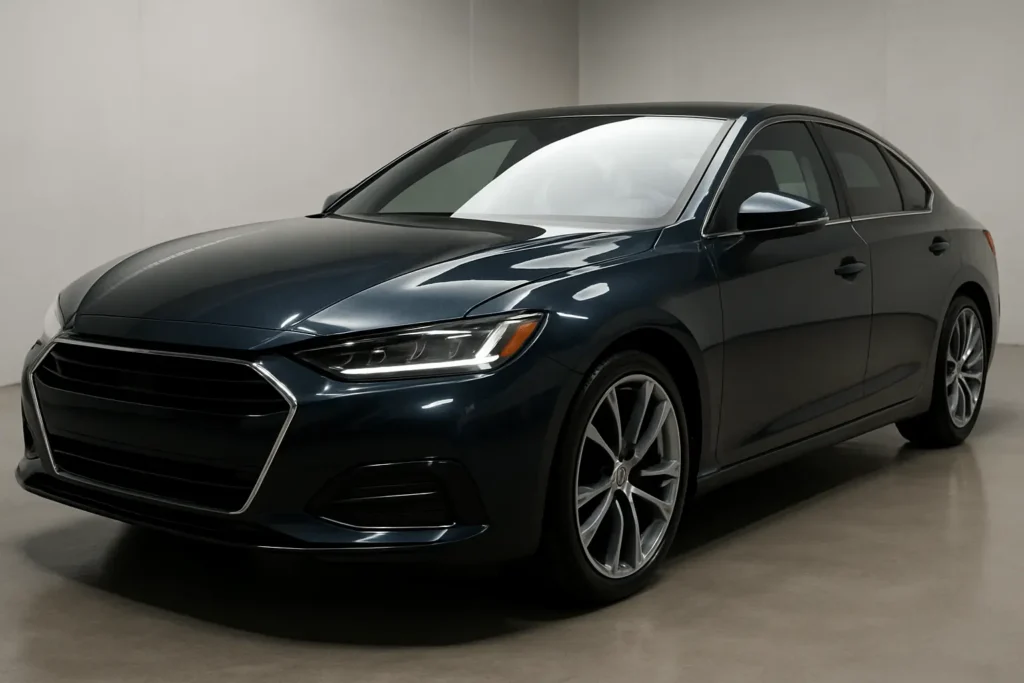
Ceramic coating works like a clear shield on your car paint. It is a special liquid that changes into a very thin, strong layer after you apply it. This layer stops dirt, water, and small scratches from harming the paint. It also makes washing your car easier and helps it stay shiny for longer. That is why many car owners like ceramic coating for long-lasting protection.
Ceramic Coating: How It Works and Why It Matters
Ceramic coating is like a clear cover on your car. You cannot see it, but it protects the paint from sun, rain, dust, and small scratches. It also keeps your car shiny and makes cleaning easier because dirt and water do not stick much. This helps your car stay looking good for a long time.
Ceramic Coating Explained
Think of ceramic coating like a clear raincoat for your car paint. You cannot see it, but it is there, keeping the paint safe from things that make it look old and dull. Once it is put on, it sticks to the car surface and stays there for a long time.
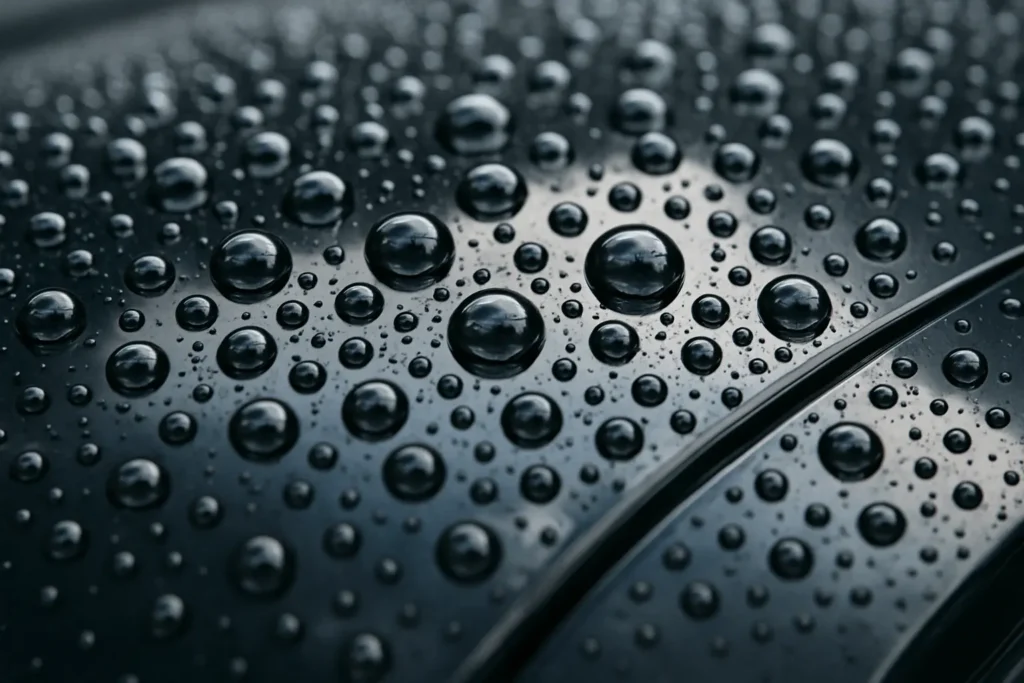
- Works like an invisible shield.
- Makes water slide off easily.
- Helps the car keep its shine for years.
Why Your Car Needs A Ceramic Coating
Your car faces many things every day, sunlight, dirt, rain, and dust. Over time, these can make the paint look faded or dirty. A ceramic coating helps stop that from happening.
- Stops sunlight from fading the paint.
- Keeps dirt from sticking, so cleaning is easier.
- Helps prevent water spots and small scratches.
What Ceramic Coating Can and Cannot Do
Ceramic coating is great, but it is not magic. Here is the truth.
It can:
- Keep your car shiny for longer.
- Make cleaning faster and easier.
- Protect the paint from many everyday hazards.
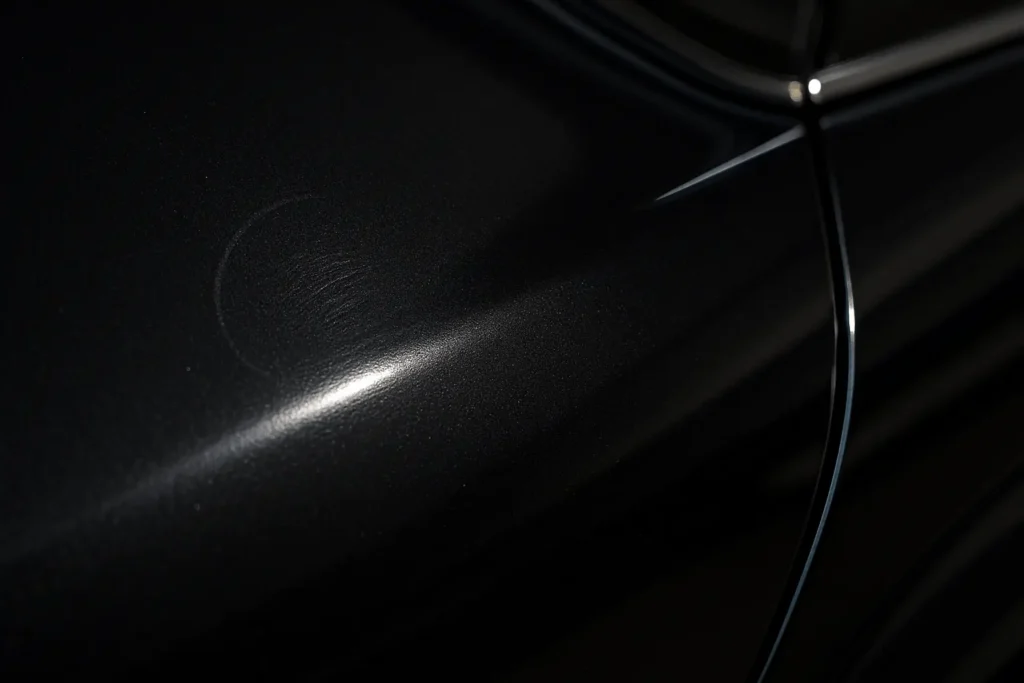
It cannot:
- Stop big scratches from accidents.
- Replace regular washing, you still need to clean your car.
- Last forever, it needs care to stay strong.
Types Of Ceramic Coatings
Before we talk about each type, let us understand one thing, a coating is like a clear jacket for your car. It helps keep the paint safe from things like sun, rain, dust, and small scratches. But not all coats are the same, and choosing the right one depends on your needs, time, and budget.
Professional Ceramic Coating
This kind is put on by trained workers at a car shop. They use a clean space and careful steps, so the coat goes on smoothly and lasts a long time.
- Strongest shield: Keeps the paint safe for the longest time.
- Weather ready: Stands up to sun, rain, and dust.
- Higher price: You pay more, but you do not do the work.
DIY Ceramic Coating
This kind is for doing at home. You buy a box with what you need and follow simple steps.
- Saves money: Costs less than a shop job.
- Home friendly: You can do it in your garage.
- Good, not longest: Protects well, but not as long as a shop job.
Ceramic Coating For Wheels And Interior
The coat can also go on the round parts that roll and on the inside parts of the car.

- Wheels stay cleaner: Dust from brakes sticks less, so washing is easier.
- Inside stays tidy: Seats and dash do not stain as easily.
The Rise Of Graphene Ceramic Coatings
A newer kind is getting popular. It can be tougher and smoother than the usual kind.
- Stays clean longer: Water and dirt roll away more easily.
- Extra shine: Makes the surface look very shiny.
- Handles heat well: Stays strong in hot and cold weather.
Choosing The Right Coating
Picking a coating is a bit like picking the right raincoat for your car. You want it to keep your car safe from things like sun, rain, dust, and tiny scratches, but you also want one that fits your budget and how you use your car.
Factors To Think About Before Buying
Before you choose, ask yourself:
- Money: How much can you spend?
- Time: Do you want it done quickly, or can you wait?
- Driving: Do you use your car a lot or only sometimes?
- Parking: Is it outside most of the time, or inside a garage?
These simple questions help you pick what works best for you.
Advantages Of Shop Applied Coatings
When a car shop puts on the coating, it usually turns out better.
- Lasts longer: You will not need a new coat for a long time.
- Looks smoother: The shine and finish are better.
- Less worry: No need to learn how to do it yourself.
It costs more, but many people like the easy, worry free result.
How To Check If A Coating Is Good
Here are three easy ways to see if the coating works well:
- Stays strong: Keeps your car safe for a long time without wearing off.
- Water rolls off: Rain or water should slide away quickly.
- Stops small marks: Helps protect from light scratches and everyday bumps.
If the coating does all this, it is a good choice.
Preparing Your Car for Coating
Before you put a coating on your car, it is important to make sure the paint looks its best. If the surface has marks or scratches, the coating will cover them up, and that means you will keep seeing them for a long time. A little fixing now will make your car shine brighter and help the coating stick better.
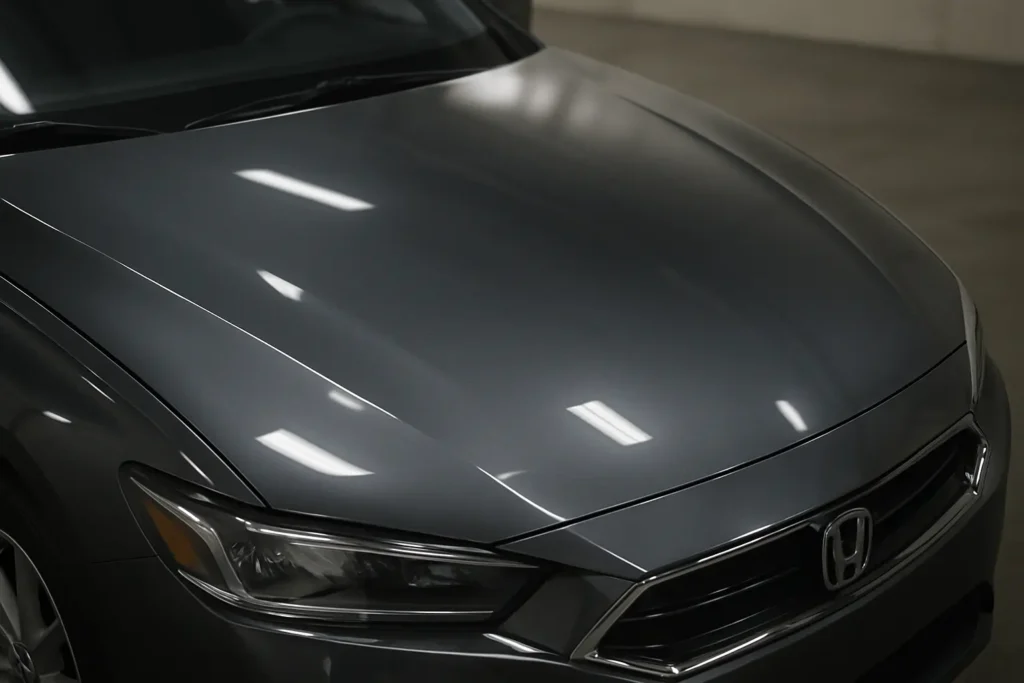
Do You Need Paint Correction?
Paint correction means fixing small marks on the paint before adding the coating. You might need it if you see:
- Light lines that look like spider webs in the sun.
- Small scratches from washing or wiping.
- Faded or dull spots on the paint.
If your car paint already looks smooth and shiny, you may not need much correction.
When Paint Correction Is Essential
Sometimes fixing the paint is a must before coating. This is true if:
- You have lots of swirl marks that make the paint look hazy.
- There are scratches you can see clearly.
- The surface feels rough when you touch it.
- Fixing these problems first will make the coating look better and last longer.
DIY vs Professional Paint Correction
You can do small fixes at home or let an expert handle them.
DIY (Do it yourself)
- Saves money.
- Good for very small marks.
- Needs care and patience.
Professional
- Costs more.
- Works for deeper marks and bigger jobs.
- Experts use the right tools for a perfect finish.
Step‑by‑Step: Applying a DIY Ceramic Coating
This guide keeps things simple so you can do a clean, careful job at home. Take your time, work in small areas, and keep everything clean and dry. Slow and steady gives the best shine.
Preparation
Before you start, your car should be very clean, smooth, and fully dry. This helps the coating stick well and look even.
- Goal: Make the paint clean, smooth to touch, and free of tiny stuck bits.
- Place: Work in the shade on a cool car. Avoid wind and dust.
- Supplies: Car soap, soft wash sponge, soft clean towels, a soft clay block, and lots of clean water.
- Rinse: Spray the car with water to knock off loose dirt.
- Wash: Use car soap and a soft sponge. Clean top to bottom. Rinse often.
- Rinse again: Wash off all soap so no film is left.
- Dry: Use soft, clean towels. Get into edges and mirrors so no drops hide.
- Feel the paint: Lightly glide your fingers in a bag or tissue over the paint. If it feels bumpy, move to the next step.
- Smooth with clay: Rub a soft clay block gently with some soapy water so it slides. Work small spots until the paint feels smooth.
- Final wipe: Dry again with a fresh, soft towel. The paint should feel like glass.
Installation Process
Work on a small area at a time. Keep your hands clean and use fresh towels when they get damp.
- Test spot: Pick a small hidden area. Try the steps below to learn the timing.
- Set up pad: Wrap the small cloth from the kit around the little pad. Keep it clean.
- Add drops: Put a few small drops on the cloth. A thin line is enough.
- Spread thin: Wipe a small square (about the size of a pillowcase) in straight lines, then cross lines. Keep the coat very thin.
- Wait a moment: Let it sit a short time until it looks a bit hazy. Do not let it dry hard.
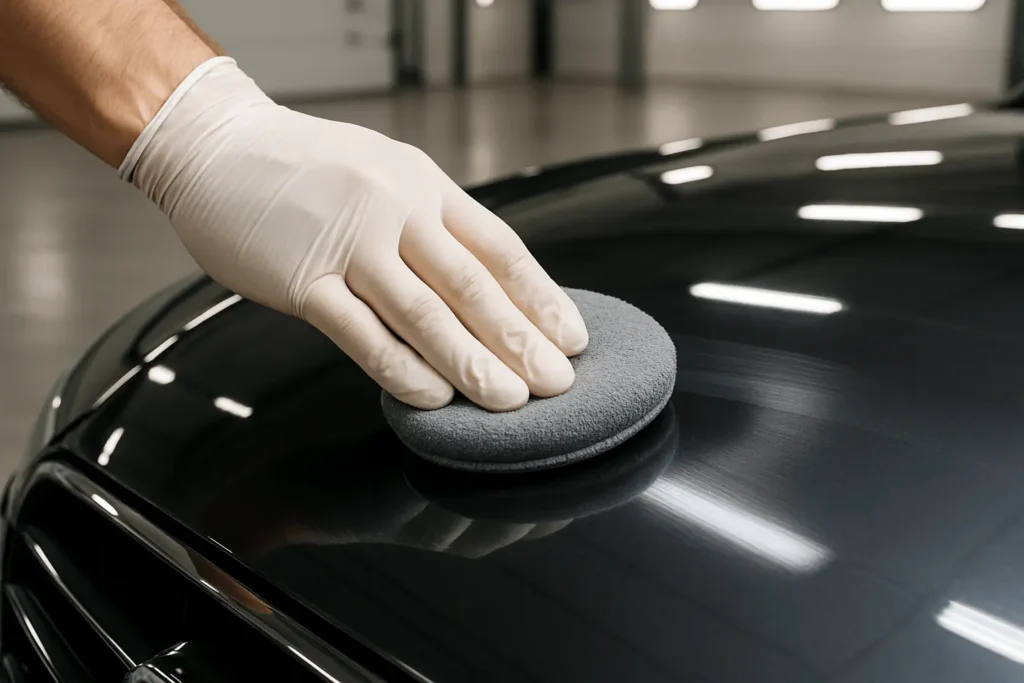
- Wipe off: Use a dry, soft towel to gently wipe the area. Use a second dry towel to finish so it looks clear.
- Check: Look from different angles under light. If you see cloudy spots, wipe again lightly.
- Repeat: Move to the next small area and do the same steps until the whole car is done.
- Edges last: Do tricky spots (near badges, door handles, and mirrors) with extra care and very little product.
Letting The Coating Cure
After you finish, the new layer needs quiet time. Keep it dry and clean so it can set well.
- First hour: Leave the car parked. Do not touch the paint.
- First day (12–24 hours): Keep it dry. No rain, no washing, no dust. If a drop lands, dab it off gently with a soft towel.
- First two days (24–48 hours): Try not to drive in rain. Keep it indoors if you can.
- First week (up to 7 days): No soap and no scrubbing. If it gets dusty, blow it off or gently rinse and pat dry.
- After one week: Wash gently with car soap and soft towels. Dry fully so no water marks stay.
- Upkeep: Wash often, dry after each wash, and avoid rough brushes. A clean car helps the shine last longer.
Maintenance and Longevity
A coating can last a long time if you care for it the right way. Think of it like a shield. It is strong, but it still needs gentle care. Small, regular steps keep the shine bright.
How To Maintain And Decontaminate A Ceramic‑coated Car
Keep the car clean and smooth. Gentle washing stops dirt from sticking and keeps the glow.
- Wash often: Clean the car every 1–2 weeks with mild car soap and cool water.
- Use soft tools: Pick a soft sponge and soft towels. No rough brushes.
- Rinse well: Wash off all the soap so nothing is left on the paint.
- Dry fully: Pat dry with a clean, soft towel to stop water spots.
- Deep clean sometimes: Every few months, use a gentle cleaner to lift stuck bits so the paint stays smooth.

Adding Extra Protection Layers
A quick top‑up can boost shine and make water roll off again.
- Use a helper spray: After washing and drying, mist on a product made for coated cars.
- Top up on a schedule: Add it every few months, or when water stops forming little drops.
- Work in shade: Spray a small area, spread thin with a clean towel, and wipe clear.
Common Mistakes To Avoid
These habits can wear the coating down faster. Skip them to keep the shield strong.
- Harsh soaps: Do not use strong cleaners or stiff brushes.
- Dirty cloths: Never wash or dry with old, gritty towels.
- Hard scrubbing: Use light pressure; let the soap do the work.
- Letting mess sit: Clean bird droppings, bugs, and tree sap as soon as you see them.
Looking Ahead: Ceramic Coating Trends 2025
New ideas are making coatings kinder to the planet, longer‑lasting, and easier to use. Here is what to expect soon.
- Kinder to the Earth: Brands are using gentler stuff with less smell and less waste.
- Stronger mixes: New blends aim to keep shine longer and help stop water spots.
- Faster set times: Fresh coats get ready sooner, so you can drive earlier.
- Easier home kits: Simple steps and safer bottles make DIY jobs less scary.
Is 9H or 10H better?
Both 9H and 10H coatings protect your car well, but 10H is slightly stronger. It lasts longer and resists scratches better.
Is wax better than ceramic coating?
Ceramic coating is much better than wax. It lasts longer, protects more, and keeps your car shiny with very little effort.
Graphene Coating vs Ceramic Coating: Which one is better?
Both protect against water, dust, and dirt. Graphene is stronger and more durable, while ceramic coating is easier to apply and maintain.
Are there disadvantages to ceramic coating?
The main drawback is cost. Professional coatings can be expensive, but they save money and effort over time by keeping your car cleaner and protected.
Can you pressure wash a ceramic-coated car?
Yes, pressure washing is safe for ceramic-coated cars. It cleans without touching the paint too much, reducing the risk of scratches.
Will polish remove ceramic coating?
Polishing can remove ceramic coating if done too hard. Light polishing is safe, but strong abrasive polish should be avoided.
Which coating is the best?
Ceramic coating protects against scratches, UV rays, and water, while Teflon mainly protects paint from stains. Ceramic coating is better for long-term paint protection.
